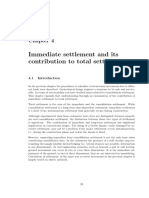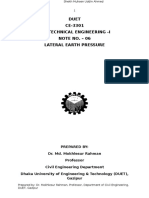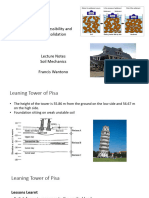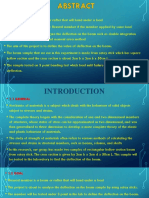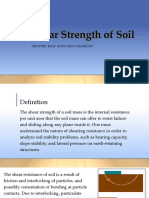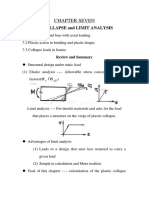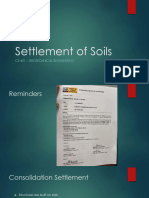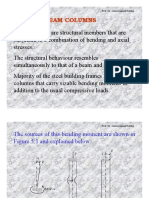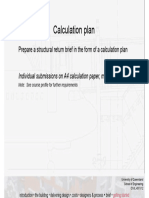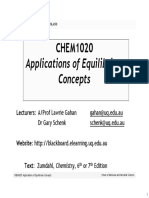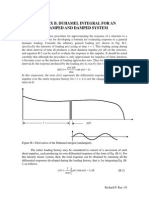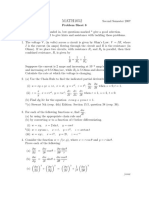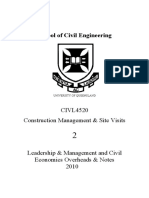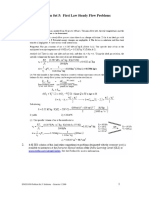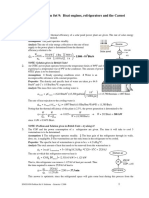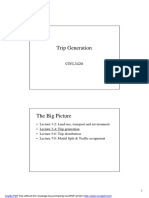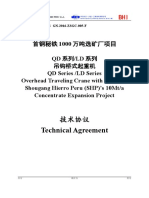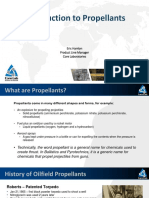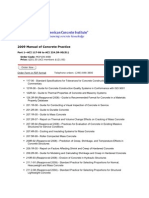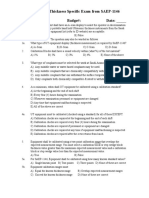1 - Earth Pressure
1 - Earth Pressure
Uploaded by
clearcastingCopyright:
Available Formats
1 - Earth Pressure
1 - Earth Pressure
Uploaded by
clearcastingOriginal Description:
Copyright
Available Formats
Share this document
Did you find this document useful?
Is this content inappropriate?
Copyright:
Available Formats
1 - Earth Pressure
1 - Earth Pressure
Uploaded by
clearcastingCopyright:
Available Formats
The University of Queensland CIVL3210 Geotechnical Engineering Earth pressure
Earth Pressure
Concerned with the retaining wall problem
What is a retaining wall? - Youll find lots of photos here
http://www.keystonewalls.com/
Look at the more general problem first Applied to ALL geotechnical analysis
What is the force the soil exerts on the wall?
What is the resistance capacity of the wall?
Overturning
Sliding
Structural capacity
Four basic requirements of a general solution
Equilibrium The stress distribution within the soil must be in equil.
Compatability There can be no holes or overlapping
Soil strength/failure laws T c + N tan
Boundary conditions Stresses and displacement must be equal to the
boundary values
In geotechnical engineering it is very difficult to satisfy all requirements without very
complex analysis. We do a lot of simplification.
Many different methods
Many different answers to the same problem (different assumptions and
approximations)
Returning to the retaining wall problem
Horizontal
extension
Active state
Horizontal
compression
Passive state
Dr Robert Day, The University of Queensland, 2009
The University of Queensland CIVL3210 Geotechnical Engineering Earth pressure
If wall slides to left there is a state of stress similar to the Rankine active and passive
stress state developed on each side of the wall.
Remember this??
1 + sin 1 + sin
1 = 3 + 2c
1 sin 1 sin
This is the failure law and is in terms of effective c 3 1
stress. 1 = K p 3 + 2c K p
1 sin 1 + sin 1
Ka = , Kp = =
1 + sin 1 sin K a
On the retained side v = 1 and h = 3 so
h = K a v 2c K a (1)
In the SPECIAL CASE - If there is no water pressure Dry retained soil v = z
the stress distribution on the wall is
- ve
h = K a z 2c K a Tension zo
Note:
2c 1 H = height of wall
h = 0 at z = z 0 =
Ka +ve
Compression
2cKa
Ka H
The Active FORCE or thrust
H
1
Pa = h dz = K a H 2 2c K a H = area of stress distribution
0
2
Implications
Tension behind the wall to depth zo. Usually tension cannot be sustained.
Crack forms. Depth of crack = z0 Crack fills with water extra load on wall.
Maximum unsupported cut, Hc, is when Pa = 0, so Hc 2.z0
Ie for undrained conditions ( = 0) the maximum unsupported cut height
should be about 4c/
Dr Robert Day, The University of Queensland, 2009
The University of Queensland CIVL3210 Geotechnical Engineering Earth pressure
On the resisting side h = 1 and v = 3 so
h = K p v + 2c K p (2)
D = depth below ground
Kp H 2cKp
D
1
Passive force Pp = h dy = K p D 2 + 2c K p D = area of stress distribution
0
2
Note:
The effect of cohesion is:
reduce the destabilizing action. Pa
increase the resisting action Pp
IE. It generally contributes to stability
Surcharge load on soil surface
Saturated soil
The above theory gives the force due to the soil only. If the soil is saturated there is
also a force due to the water pressure (pore pressure)
Look at other forces that a retaining wall must resist.
Dr Robert Day, The University of Queensland, 2009
The University of Queensland CIVL3210 Geotechnical Engineering Earth pressure
A load is often applied to the soil surface
q
The soil is usually saturated
Both these actions increase the force that
Dry soil
a retaining wall must resist.
Saturated soil
Use equation (1). This gives the horizontal earth pressure in terms of the vertical
effective stress. Note that now v z. We need to calculate the pore pressure
distribution and the vertical effective stress distribution. Equation (1) gives the
horizontal earth pressure. The total horizontal force on the wall is equal the earth
pressure (effective stress) plus the water pressure.
(always remember this: total stress = pore pressure + effective stress)
Similarly for the passive side of the wall use equation (2) plus water pressure
Passive side Active side
Soil Water Water Surcharge Soil
Wall friction
So far we have discussed the Rankin stress distribution. This is a very special case.
The Rankine stress distribution has zero shear stress on vertical
planes. Hence for the Rankine stress distribution to be valid there
can be no friction force on the wall. Ie the wall is SMOOTH.
Effect of wall friction Pa
Net force on wall is inclined
Reduces active force
Increases passive force
Pp
Dr Robert Day, The University of Queensland, 2009
The University of Queensland CIVL3210 Geotechnical Engineering Earth pressure
Rankines method will be conservative if friction is ignored
Rankines method can be extended to include inclined soil (planar) surface but the
analysis is very complex. Chart solutions are available.
Assumptions Rankins method
Soil surface - Horizontal or inclined planes
No concentrated loads on surface
Vertical wall surfaces
Sufficient movement must occur
No friction between wall and soil
Hydrostatic water pressure no seepage
Coulombs theory of earth pressure
Coulomb 1773 - 100 years before Rankine
Basic concept is to assume a failure by a block of soil sliding along a failure surface.
Assumes:
A particular failure surface
Block and soil are rigid
Problems:
Does not consider stress distribution within block
Does not consider stress distribution in soil outside the block
The failure condition is only satisfied on the assumed surface. It may actually
be violated elsewhere. Ie within the block
The method is a limit equilibrium method
The method is an engineering approximation. We postulate a failure mechanism and
look at its equilibrium.
Can take into account:
Friction between wall and soil
Sloping and irregular soil surfaces
Sloping back of wall
Surcharges - uniform or concentrated
Simple or complex pore pressure regimes eg. unsteady seepage
Dr Robert Day, The University of Queensland, 2009
The University of Queensland CIVL3210 Geotechnical Engineering Earth pressure
Examples:
Dry soil effective stress analysis (long term)
F
q
Pa
R
Known and unknown quantities
Quantity Magnitude Direction Line of action
W 3 3 3
R 2 3 2
Forces on soil
Pa 2 3 2
wedge
q 3 3 3
F 3 3 3
3 - -
Soil and
3 - -
geometric
3 - -
parameters
3 - -
We want to find Pa.
This is the FORCE that the wall must exert to keep the block in equilibrium. Looking
at a free body diagram. Pa can be thought of as the force exerted on the wall.
We have 2 unknowns and 2 equations of equilibrium SOLVE
Graphical OR analytical methods Pa
F + q
This give Pa for the given assumed failure
Dr Robert Day, The University of Queensland, 2009
The University of Queensland CIVL3210 Geotechnical Engineering Earth pressure
plane or wedge
Considers force equilibrium only - Moment equilibrium ??
Is this the worst case?
Try others, (vary the angle ) plot graph of P vs
Determine max force
Summary
1. Chose a failure surface
2. Calculate forces
3. Draw force polygon (or solve analytically)
4. Obtain P
5. Chose another surface
6. Repeat 2 to 6 to find the maximum value of P and the location of the critical
failure surface
Coulombs method gives total force not pressure distribution.
Can derive equation for simple geometry
1
Pa = K a H 2 K ac c H
2
this implies a linear pressure distribution - similar to Rankine theory
Value of Ka is (in general) not the same as Rankine solution, because of the
inclusion of the effect of wall friction.
To calculate the pressure on the wall we need an additional assumption
The shape of the pressure distribution is assumed.
Effect of pore pressure
Work in terms of effective stress
= + u
u0
Pa
Consider soil pressure - - and water pressure
separately
Pw
Resultant
Hydrostatic W
R
W
Pa R q
Pw Rw
RW
Dr Robert Day, The University of Queensland, 2009
The University of Queensland CIVL3210 Geotechnical Engineering Earth pressure
Pa
Pw
Resultant force on wall
Resultant force on wall = sum of water and soil pressure
Ie Pa + Pw (this is a vector equation)
Note
Pw is the same for each trial failure surface
Pw increases the force on the wall
Steady seepage
Drains can reduce the total force on the wall
Same principals and method apply
But need to calculate the pore pressure distribution flow net
Most likely that Pw on wall = 0
Reduces pore pressure on failure surface, hence increased strength (very
significant)
Soils with apparent cohesion
Effective stress analysis (we can calculate pore pressure)
c 0
0
Require some modifications to wedge
Adhesion force between wall and soil cw
Cohesion force on failure surface c
Tension cracks possible top depth zc (the depth is usually estimated from a
Rankine analysis)
Tension cranks fill with water
F
q
Pwc
Pwc D
A W
Pa cw c
R
Pw B Rw
Dr Robert Day, The University of Queensland, 2009
The University of Queensland CIVL3210 Geotechnical Engineering Earth pressure
Known and unknowns
Quantity Magnitude Direction Line of action
W 3 3 3
R 2 3 2
Pa 2 3 2
3
c ( = c.BD)
3 3
3
cw 3 3
(= cw.AB)
3
Pwc 1
(= z 2 )
3 3
c
2
W 3 3 3
Pw 3 3 3
F 3 3 3
q 3 3 3
We want to find Pa.
Pa Pa
Pwc
Pw Pwc
Pw
cw Resultant
cw
W
Resultant
R = total force on wall
Pwc
c
F + q
Rw
Passive pressure
Be careful with directions of forces
The forces are such that they oppose movement W
Method of analysis is the same cw
Pp
Observed failure surfaces are more curved in the c
passive zone than the active zone. Using a
straight failure surface has greater error. R
Dr Robert Day, The University of Queensland, 2009
The University of Queensland CIVL3210 Geotechnical Engineering Earth pressure
General formula
Coulombs method implies an equation in the following form. Other limit equilibrium
methods also imply the same.
h = K a v K ac c
This is the same form as the Rankine formula h = K a v 2c K a
Wall friction and adhesion is often less than the soil friction and cohesion. Ie.
Failure through soil, = n tan + c
Failure on wall surface, = n tan + cw
The values of Ka and Kac are dependent on the wall friction as well as the soil
strength. The effect of wall friction is usually included in the Ka and Kac.
Similarly for passive pressure
h = K p v + K pc c
cw
K ac = 2 K a (1 + )
c
c
K pc = 2 K p (1 + w )
c
Charts and tables give values of Ka, Kp, Kac, Kpc using more complex techniques
and assumptions. Be careful with usage
Horizontal component or resultant ?
Horizontal soil surface is commonly assumed
Dry soil
Vertical back on wall
Total thrust or pressure distribution
Dr Robert Day, The University of Queensland, 2009
The University of Queensland CIVL3210 Geotechnical Engineering Earth pressure
Active pressure coefficient - Caquot and Kerisel
Horizontal component of pressure
Vertical wall, Horizontal soil surface
Coefficient for horizontal component of earth pressure Kah
Wall friction, /
0.0 0.2 0.4 0.5 0.6 0.8 1.0
10 0.704 0.685 0.669 0.662 0.656 0.644 0.639
15 0.589 0.567 0.549 0.541 0.533 0.520 0.513
20 0.490 0.468 0.450 0.442 0.434 0.421 0.413
25 0.406 0.385 0.368 0.360 0.353 0.340 0.333
30 0.333 0.315 0.299 0.293 0.286 0.274 0.267
35 0.271 0.255 0.242 0.236 0.230 0.219 0.213
40 0.217 0.205 0.193 0.188 0.183 0.174 0.168
45 0.172 0.161 0.152 0.148 0.144 0.136 0.131
50 0.132 0.125 0.118 0.114 0.111 0.105 0.100
Dr Robert Day, The University of Queensland, 2009
The University of Queensland CIVL3210 Geotechnical Engineering Earth pressure
Passive pressure coefficient - Caquot and Kerisel
Horizontal component of pressure
Vertical wall, Horizontal soil surface
Coefficient for horizontal component of earth pressure Kph
Wall friction, /
0.0 0.2 0.4 0.5 0.6 0.8 1.0
10 1.42 1.48 1.52 1.55 1.57 1.61 1.62
15 1.70 1.82 1.92 1.97 2.02 2.10 2.12
20 2.04 2.26 2.45 2.55 2.65 2.80 2.83
25 2.46 2.85 3.21 3.39 3.57 3.85 3.89
30 3.00 3.67 4.31 4.63 4.95 5.50 5.56
35 3.69 4.81 5.97 6.56 7.16 8.25 8.36
40 4.60 6.51 8.63 9.76 10.93 13.18 13.44
45 5.83 9.14 13.20 15.49 17.93 23.00 23.71
50 7.58 13.55 21.87 26.89 32.58 45.39 47.79
Dr Robert Day, The University of Queensland, 2009
The University of Queensland CIVL3210 Geotechnical Engineering Earth pressure
Comparison of different methods for calculating the Earth pressure coefficient
Resultant pressure on wall. These coefficients give the magnitude of the
pressure/force inclined at angle to the horizontal.
Active pressure coefficient, Ka
Soil Wall Coulomb Caquot & Sokolovskii Chen
strength friction Kerisel
0 0 1.000 1.000 1.000 1.000
10 0 0.704 0.704 0.70 0.704
5 0.662 0.665 0.66 0.664
10 0.635 0.649 0.65 0.642
20 0 0.490 0.490 0.49 0.490
10 0.447 0.449 0.45 0.448
20 0.427 0.440 0.44 0.434
30 0 0.333 0.333 0.33 0.333
15 0.301 0.303 0.30 0.302
30 0.297 0.308 0.31 0.303
40 0 0.217 0.217 0.22 0.217
20 0.199 0.200 0.20 0.200
40 0.210 0.219 0.22 0.214
Passive pressure coefficient, Kp
Soil Wall Coulomb Caquot & Sokolovskii Chen
strength friction Kerisel
0 0 1.00 1.00 1.00 1.00
10 0 1.42 1.42 1.42 1.42
5 1.57 1.55 1.56 1.56
10 1.73 1.64 1.66 1.68
20 0 2.04 2.04 2.04 2.04
10 2.63 2.59 2.55 2.58
20 3.52 3.01 3.04 3.17
30 0 3.00 3.00 3.00 3.00
15 4.98 4.78 4.62 4.71
30 10.10 6.42 6.55 7.10
40 0 4.60 4.59 4.60 4.60
20 11.77 10.36 9.69 10.10
40 17.50 18.20 20.90
Dr Robert Day, The University of Queensland, 2009
The University of Queensland CIVL3210 Geotechnical Engineering Earth pressure
Total stress analysis
Same principals
Used in saturated soils for short term undrained situation = 0
In this situation we dont know the pore pressure distribution and have to use total
stress analysis
For total stress analysis the same general formula applies - noting that = = 0, and
hence Ka = Kp = 1 (for a vertical wall)
the formulae can be written as:
h = v K ac c u
h = v + K pc c u
cw
K ac = K pc = 2 1 +
cu
Usually it is recommended that cw 0.5 cu
Critical situations
Saturated fill (compacted granular) short term usual most critical. Build in +ve pore
pressures dissipate to give higher effective stress in the long term. If you can build it -
it will be OK
Excavation in clay Long term most critical. Excavation - Suction high effective
stress dissipation lower effective stress weaker soil.
Some web sites about design and other propriety systems
http://www.versa-lok.com/frmset.htm
http://www.keystonewalls.com/
http://www.inter-block.com/design.html
http://www.reco.aust.com/
http://www.concretenetwork.com/concrete/segmental_retaining/retaining_wall_desig
n.htm
Dr Robert Day, The University of Queensland, 2009
You might also like
- Chapter 1 - IntroductionDocument26 pagesChapter 1 - IntroductionEvo LanzNo ratings yet
- Chapter 4 - Immediate and Total SettlementDocument10 pagesChapter 4 - Immediate and Total SettlementfNo ratings yet
- Chapter 3 Lateral Earth PressureDocument20 pagesChapter 3 Lateral Earth PressureEba GetachewNo ratings yet
- Foundation Settlement Secondary ConsolidationDocument5 pagesFoundation Settlement Secondary Consolidationxingze luNo ratings yet
- 3.2.7 Rankine's Earth Pressure in Cohesive SoilsDocument21 pages3.2.7 Rankine's Earth Pressure in Cohesive SoilsMriduNo ratings yet
- Lateral Earth PressureDocument33 pagesLateral Earth PressureShekh Muhsen Uddin Ahmed100% (1)
- Seismic Slope StabilityDocument4 pagesSeismic Slope StabilitybatuaydoganNo ratings yet
- P1. Anchored Sheet Pile Wall OuestionDocument10 pagesP1. Anchored Sheet Pile Wall OuestionShaminda AmbaheraNo ratings yet
- CEN 512 Shear Strength of SoilsDocument5 pagesCEN 512 Shear Strength of SoilsRustom RemorozaNo ratings yet
- Lecture Notes PPT 4 PDFDocument17 pagesLecture Notes PPT 4 PDFDrRoja A RNo ratings yet
- Module 1 - Analysis of Stress in 3DDocument77 pagesModule 1 - Analysis of Stress in 3DVINAYAK SHARMANo ratings yet
- Compressibility and ConsolidationDocument78 pagesCompressibility and ConsolidationKim PiusNo ratings yet
- 2.2 Calculation of Consolidation SettlementDocument23 pages2.2 Calculation of Consolidation SettlementrihongkeeNo ratings yet
- 6300 Weirs For Flow Measurement Lecture Notes 1Document14 pages6300 Weirs For Flow Measurement Lecture Notes 1Fatima Al-DoskiNo ratings yet
- Lecture 3 Shear Strength of Soil Part 1Document32 pagesLecture 3 Shear Strength of Soil Part 1F.a.AlfredThomNo ratings yet
- Stress and Strain in Pure ShearDocument22 pagesStress and Strain in Pure ShearTiofelus H. HamutenyaNo ratings yet
- Advanced Structural Mechanics (CSE 20204) Lecture 3: OutlineDocument8 pagesAdvanced Structural Mechanics (CSE 20204) Lecture 3: OutlineYUK LAM WONGNo ratings yet
- Chapter 2.b (Force in 2D Particle)Document27 pagesChapter 2.b (Force in 2D Particle)LogarithemNo ratings yet
- Non-Uniform Flow in Channels PDFDocument78 pagesNon-Uniform Flow in Channels PDFsanjana jainNo ratings yet
- Shear Strength of SoilDocument7 pagesShear Strength of SoilRenz Pagcaliwagan100% (1)
- 1 - Lateral Earth PressureDocument7 pages1 - Lateral Earth Pressureone engNo ratings yet
- 5.0 ConsolidationDocument35 pages5.0 Consolidationchurchill ochiengNo ratings yet
- JJ310 STRENGTH OF MATERIAL Chapter 5 (B) Beam DeflectionDocument18 pagesJJ310 STRENGTH OF MATERIAL Chapter 5 (B) Beam DeflectionAh TiangNo ratings yet
- Moment Area Method ProjectDocument36 pagesMoment Area Method Projectfarisdanialfadli100% (1)
- Chapter 6 - Stress and Strain TransformationDocument56 pagesChapter 6 - Stress and Strain TransformationTomorrow PavingNo ratings yet
- Structural Engineering: Matrix Methods of AnalysisDocument21 pagesStructural Engineering: Matrix Methods of AnalysisAdnan AhmadNo ratings yet
- Pile Foundations: MR Mohd Faiz B Mohammad ZakiDocument24 pagesPile Foundations: MR Mohd Faiz B Mohammad ZakiMohammad Hafiz MahadzirNo ratings yet
- Stress in SoilDocument52 pagesStress in SoilHari Krishnan0% (1)
- Shear Strength of SoilDocument46 pagesShear Strength of SoilGlyra Rosalem100% (1)
- Roscoe and Hvorselev Boundary ConditionsDocument7 pagesRoscoe and Hvorselev Boundary Conditionssravyasai13No ratings yet
- Topic 6 - Lateral - Earth - StressDocument48 pagesTopic 6 - Lateral - Earth - StressAslam ChohanNo ratings yet
- Plastic Collapse PDFDocument13 pagesPlastic Collapse PDFrajashrismdNo ratings yet
- Bearing Capacity 120405032828 Phpapp01Document32 pagesBearing Capacity 120405032828 Phpapp01Dissasekara0% (1)
- Consolidation and Compression of SoilDocument11 pagesConsolidation and Compression of SoilJogi Agung Silalahi100% (1)
- Geotechnical Engineering - Ii (Foundation Engineering) : Braced SheetingsDocument9 pagesGeotechnical Engineering - Ii (Foundation Engineering) : Braced SheetingsPascasio PascasioNo ratings yet
- Problem Set No. 1 Tekiner, Aldrien CE1Document23 pagesProblem Set No. 1 Tekiner, Aldrien CE1Aldrien TekinerNo ratings yet
- Design of Footing Combined (Rectangular) (D) Eng Mutasem AlzukahyDocument13 pagesDesign of Footing Combined (Rectangular) (D) Eng Mutasem AlzukahyAltayeb YassinNo ratings yet
- Lec1 Soil Mechanics Lec 2015-2016Document2 pagesLec1 Soil Mechanics Lec 2015-2016Jayson Abejar100% (2)
- Soil-Bearing Capacity For Shallow FoundationsDocument9 pagesSoil-Bearing Capacity For Shallow FoundationsNguyễn Thanh TrựcNo ratings yet
- Lateral Earth PressureDocument2 pagesLateral Earth PressureLaura HernandezNo ratings yet
- Monday-6: Stress Paths, State Paths and Use of Voids RatioDocument83 pagesMonday-6: Stress Paths, State Paths and Use of Voids RatioArta Dwi PutraNo ratings yet
- 5-SLS - Deflection Control (2019) PDFDocument15 pages5-SLS - Deflection Control (2019) PDFMayoo LaxmanNo ratings yet
- 03-Hydrostatics Hydrokinematics HydrodynamicsDocument30 pages03-Hydrostatics Hydrokinematics HydrodynamicsSarmad KhanNo ratings yet
- Planar FailureDocument37 pagesPlanar FailureWeltmeisterNo ratings yet
- Lateral Earth Pressure Part 2Document2 pagesLateral Earth Pressure Part 2Rajesh KhadkaNo ratings yet
- Combined FootingsDocument8 pagesCombined FootingsJason Rodriguez100% (1)
- Stress TransformationDocument22 pagesStress TransformationTran Manh HuyNo ratings yet
- Lateral Earth PresDocument36 pagesLateral Earth PresSyed Muhammad Mohsin100% (1)
- Settlement of SoilsDocument19 pagesSettlement of Soilsvalerie candoNo ratings yet
- Ch3 ConsolidationDocument46 pagesCh3 Consolidation彭宇鑫No ratings yet
- 19 - Beam ColumnsDocument95 pages19 - Beam ColumnsArfan HaiderNo ratings yet
- Steel Structures - Lecture 2Document13 pagesSteel Structures - Lecture 2Mr. Danish SaeedNo ratings yet
- MTPPT4 - Design of Isolated FootingDocument19 pagesMTPPT4 - Design of Isolated FootingMineski Prince GarmaNo ratings yet
- Problem # (16) : Solved Problems in Foundation EngineeringDocument8 pagesProblem # (16) : Solved Problems in Foundation EngineeringHaron Delon CE100% (1)
- Retaining Wall ReporterDocument18 pagesRetaining Wall ReporterJoefel BessatNo ratings yet
- 17 SM II Lateral Earth Pressure PDFDocument75 pages17 SM II Lateral Earth Pressure PDFnaumanNo ratings yet
- Chapter 1 - Vertical Stresses Distribution in SoilDocument111 pagesChapter 1 - Vertical Stresses Distribution in SoilWHfamilyNo ratings yet
- In-Situ Stresses in SoilDocument26 pagesIn-Situ Stresses in SoilhashimshahNo ratings yet
- Pressure, Resistance, and Stability of Earth American Society of Civil Engineers: Transactions, Paper No. 1174, Volume LXX, December 1910From EverandPressure, Resistance, and Stability of Earth American Society of Civil Engineers: Transactions, Paper No. 1174, Volume LXX, December 1910No ratings yet
- Feynman Lectures Simplified 2B: Magnetism & ElectrodynamicsFrom EverandFeynman Lectures Simplified 2B: Magnetism & ElectrodynamicsNo ratings yet
- Mineral SummaryDocument2 pagesMineral SummaryclearcastingNo ratings yet
- Task 1Document1 pageTask 1clearcastingNo ratings yet
- Task 2Document5 pagesTask 2clearcastingNo ratings yet
- Year 12 Physics Exam ReviewDocument7 pagesYear 12 Physics Exam ReviewclearcastingNo ratings yet
- Information BookletDocument6 pagesInformation BookletclearcastingNo ratings yet
- Reynolds Number: Re: VL VLDocument19 pagesReynolds Number: Re: VL VLclearcastingNo ratings yet
- CHEM1020 Module4 ViewingDocument180 pagesCHEM1020 Module4 ViewingclearcastingNo ratings yet
- CHEM1020 Module2 ViewingDocument265 pagesCHEM1020 Module2 ViewingclearcastingNo ratings yet
- CHEM1020 Module1 ViewingDocument199 pagesCHEM1020 Module1 ViewingclearcastingNo ratings yet
- Duhamel IntegrationDocument8 pagesDuhamel IntegrationbuddhiwisrNo ratings yet
- Finite Element Analysis TutorialDocument3 pagesFinite Element Analysis TutorialclearcastingNo ratings yet
- Course Notes 3 PDFDocument65 pagesCourse Notes 3 PDFclearcastingNo ratings yet
- Prob 6Document2 pagesProb 6clearcastingNo ratings yet
- Course Notes 2 PDFDocument108 pagesCourse Notes 2 PDFclearcastingNo ratings yet
- ENGG1050 Problem Set 5: First Law Steady Flow Problems SolutionsDocument8 pagesENGG1050 Problem Set 5: First Law Steady Flow Problems SolutionsclearcastingNo ratings yet
- Solutions ProblemSet9 Sem22007Document3 pagesSolutions ProblemSet9 Sem22007clearcastingNo ratings yet
- Prob 7Document1 pageProb 7clearcastingNo ratings yet
- Solutions ProblemSet8 Sem22007Document7 pagesSolutions ProblemSet8 Sem22007clearcastingNo ratings yet
- Trip Generation: CIVL3420Document15 pagesTrip Generation: CIVL3420clearcastingNo ratings yet
- Solutions ProblemSet10 Sem22007Document4 pagesSolutions ProblemSet10 Sem22007clearcastingNo ratings yet
- 打印 吊钩桥式起重机技术协议 (中英)Document21 pages打印 吊钩桥式起重机技术协议 (中英)Yinder Vega OsorioNo ratings yet
- Lead (PB) - Free Solder Applications: ElectronicDocument12 pagesLead (PB) - Free Solder Applications: Electronicshaky4uNo ratings yet
- Consolidated Drained Triaxial Compression Test For SoilsDocument11 pagesConsolidated Drained Triaxial Compression Test For SoilsmickyfelixNo ratings yet
- Soil Genesis and Soil FormationDocument12 pagesSoil Genesis and Soil FormationShean FlorNo ratings yet
- En 772 22 2019Document11 pagesEn 772 22 2019Veronica GozdalskaNo ratings yet
- Unit 3 - Electrochemistry II Class NotesDocument22 pagesUnit 3 - Electrochemistry II Class Noteschris black MateusNo ratings yet
- b1-13 S1xbig Series eDocument19 pagesb1-13 S1xbig Series eFredy DanielNo ratings yet
- Assignment AC U2 Final eDocument28 pagesAssignment AC U2 Final eYuenHei KwokNo ratings yet
- Introduction To Propellants - Corelab - KodiakDocument19 pagesIntroduction To Propellants - Corelab - KodiakJorge Arraiz SanchezNo ratings yet
- QUALICOAT Specifications 2021 MASTER VERSION V02Document88 pagesQUALICOAT Specifications 2021 MASTER VERSION V02Pedro GalegoNo ratings yet
- MSDS - Therban 4367Document7 pagesMSDS - Therban 4367Nisa SutopoNo ratings yet
- SAFT BatteryDocument22 pagesSAFT BatteryMohamed MeeranNo ratings yet
- AHAM Company Profile CP-UAE-2019Document99 pagesAHAM Company Profile CP-UAE-2019Anonymous vD45HX6pQNo ratings yet
- SPAB Technical Advice Note-Repair of Wood WindowsDocument18 pagesSPAB Technical Advice Note-Repair of Wood Windowsashraf haniaNo ratings yet
- Super Speed Machining PDFDocument6 pagesSuper Speed Machining PDFLingaiyan SurenNo ratings yet
- 2 Ethhexanol SpecificationsDocument2 pages2 Ethhexanol SpecificationsMahmoud El-KholyNo ratings yet
- Achieving Circular Economy-NITI AayogDocument37 pagesAchieving Circular Economy-NITI Aayogsunshine7883No ratings yet
- Science Modules For Grade 7Document18 pagesScience Modules For Grade 7Amerose A. Arrieta86% (29)
- Civil Engineering Laboratory DSTDocument6 pagesCivil Engineering Laboratory DSTJuhil ZalavadiyaNo ratings yet
- The University Hospital BuildingDocument53 pagesThe University Hospital BuildingAbed SolimanNo ratings yet
- ACI 2009 Manual of Concrete PracticeDocument11 pagesACI 2009 Manual of Concrete PracticeAgnes Digal100% (2)
- Tata Graphene ProjectDocument24 pagesTata Graphene ProjectAnand GuptaNo ratings yet
- Datasheet - 5 IEU X 1950 X S135 X R2 31.5 FT - 658 X 312 X TSDS50 X 135 Ksi SMYS - 14 Box 11 Pin - HB Box - 60 70 MUT - 1.0 FF and 1.15 FF - TSC DP Web Site 1Document2 pagesDatasheet - 5 IEU X 1950 X S135 X R2 31.5 FT - 658 X 312 X TSDS50 X 135 Ksi SMYS - 14 Box 11 Pin - HB Box - 60 70 MUT - 1.0 FF and 1.15 FF - TSC DP Web Site 1oscar0% (1)
- Proximate Analysis of New Zealand and Australian Coals by ThermogravimetryDocument8 pagesProximate Analysis of New Zealand and Australian Coals by ThermogravimetryLuisana MolinaNo ratings yet
- Calorific Value of Coal - A Useful DetailDocument5 pagesCalorific Value of Coal - A Useful Detailkaruna346No ratings yet
- Consistency of SoilDocument4 pagesConsistency of SoilLyzette LeanderNo ratings yet
- 02.02 - Alternative LubricantsDocument3 pages02.02 - Alternative LubricantsNazar Khan100% (1)
- PDFDocument29 pagesPDFCarlosAlbertoGrimaldoBarajasNo ratings yet
- Manual UT Thickness Specific Exam From SAEP-1146 Name: Badge#: DateDocument5 pagesManual UT Thickness Specific Exam From SAEP-1146 Name: Badge#: DateMohamed IbrahimNo ratings yet
- Nano FertilizerDocument9 pagesNano FertilizerpaoloNo ratings yet

